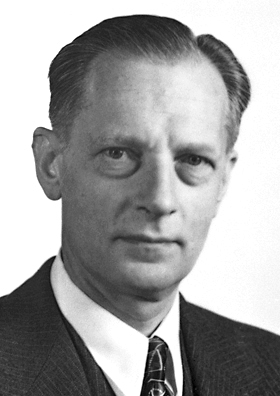Carl Ferdinand Cori facts for kids
Quick facts for kids
Carl Ferdinand Cori
|
|
|---|---|
 |
|
| Born | December 5, 1896 |
| Died | October 20, 1984 (aged 87) Cambridge, Massachusetts, U.S.
|
| Nationality | Austrian-Hungarian |
| Citizenship | United States |
| Alma mater |
|
| Known for | Metabolism of carbohydrates |
| Spouse(s) |
Anne Fitzgerald-Jones
(m. 1960) |
| Children | 1 |
| Awards |
|
| Scientific career | |
| Fields | Biochemistry |
| Institutions | Washington University in St. Louis |
| Influenced | Arthur Kornberg |

Carl Ferdinand Cori (born December 5, 1896 – died October 20, 1984) was an important scientist. He was a biochemist and pharmacologist from Prague, which was then part of Austria-Hungary. Carl Cori, along with his wife Gerty Cori and another scientist named Bernardo Houssay, won a Nobel Prize in 1947.
They won the prize for figuring out how our bodies use sugar for energy. They discovered how a type of sugar called glucose is changed into glycogen (which is like stored energy in animals) and then broken down again when the body needs energy. Their work helped us understand how our bodies get and use energy from food. In 2004, both Carl and Gerty Cori were recognized as a National Historic Chemical Landmark for their amazing work on how our bodies handle carbohydrates.
Growing Up and Studying
Carl was the son of Carl Isidor Cori, who was a zoologist (a scientist who studies animals). Carl grew up in Trieste, where his father was in charge of a marine biology station. This is a place where scientists study sea life.
In 1914, Carl's family moved to Prague. There, Carl started studying medicine at Charles University. This is where he met his future wife, Gerty Theresa Radnitz.
During his studies, Carl was called to serve in the Austro-Hungarian Army. He first joined the ski corps and later worked in the medical part of the army. He even set up a laboratory in Trieste. After the war ended, Carl and Gerty finished their medical studies in 1920. They got married that same year and began working together in clinics in Vienna.
A Career in Science
Carl was invited to work with another famous scientist, Otto Loewi, in Graz. They studied how nerves affect the heart. Otto Loewi later won a Nobel Prize for this work.
A year later, Carl was offered a job in Buffalo, New York, at a research center for diseases. So, Carl and Gerty moved to the United States. In 1928, they became citizens of the U.S.
While in Buffalo, the Coris focused their research on how the body uses carbohydrates (like sugars and starches). In 1929, they described something called the Cori cycle. This cycle explains how the body stores and uses energy from carbohydrates.
In 1931, Carl moved to Washington University School of Medicine in St. Louis, Missouri. He became a professor there and continued his research with Gerty. They kept studying glycogen and glucose, and they found an important enzyme called glycogen phosphorylase. This enzyme helps break down glycogen for energy.
For these amazing discoveries, Carl and Gerty Cori received the Nobel Prize in Physiology or Medicine in 1947. They were the third married couple ever to win a Nobel Prize!
Gerty Cori passed away in 1957. Carl later married Anne Fitzgerald-Jones in 1960. Carl stayed at Washington University until 1966, when he retired. After that, he became a visiting professor at Harvard University and continued his research in genetics. He worked with another geneticist, Salome Gluecksohn-Waelsch, until the 1980s.
Carl Cori has a special star on the St. Louis Walk of Fame, just like his wife Gerty.
Awards and Special Recognitions
Besides the Nobel Prize, Carl Cori received many other honors.
- He won the Albert Lasker Award for Basic Medical Research in 1946.
- In 1959, he received the Austrian Decoration for Science and Art.
- He was also chosen as a Foreign Member of the Royal Society in 1950.
- There is even a special professorship at Washington University named after him, called the Carl Cori Endowed Professorship.
See also
 In Spanish: Carl Ferdinand Cori para niños
In Spanish: Carl Ferdinand Cori para niños

